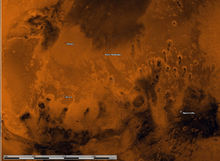Mars 2
The orbiter's primary scientific objectives were to image the Martian surface and clouds, determine the temperature on Mars, study the topography, composition and physical properties of the surface, measure properties of the atmosphere, monitor the solar wind and the interplanetary and Martian magnetic fields, and act as a communications relay to send signals from the landers to the Earth.
[4] The Mars 2 orbiter sent back data covering the period from December 1971 to March 1972, although transmissions continued through August.
The images and data revealed mountains as high as 22 kilometres (14 mi), atomic hydrogen and oxygen in the upper atmosphere, surface temperatures ranging from −110 to 13 °C (−166 to 55 °F), surface pressures of 5.5 to 6 mbar (0.55 to 0.6 kPa), water vapor concentrations 5,000 times less than in the Earth's atmosphere, the base of the ionosphere starting at 80 to 110 kilometres (50 to 68 mi) altitude, and grains from dust storms as high as 7 kilometres (4.3 mi) in the atmosphere.
The images and data enabled the creation of surface relief maps,[5] and gave information on Martian gravity and magnetic fields.
The main and auxiliary parachutes, the engine to initiate the landing, and the radar altimeter were mounted on the top section of the lander.
The lander was equipped with two television cameras with a 360 degree view of the surface as well as a mass spectrometer to study atmospheric composition; temperature, pressure, and wind sensors; and devices to measure mechanical and chemical properties of the surface, including a mechanical scoop to search for organic materials and signs of life.
Four aerials protruded from the top of the sphere to provide communications with the orbiter via an onboard radio system.
Two small metal rods were used for autonomous obstacle avoidance, as radio signals from Earth would take too long to drive the rovers using remote control.
The rover was planned to be placed on the surface after landing by a manipulator arm and to move in the field of view of the television cameras and stop to make measurements every 1.5 metres (4 ft 11 in).
After entering the atmosphere at approximately 6 km/s, the descent system on the module malfunctioned, possibly because the angle of entry was too steep.




 Clickable image:
Clicking on the labels will open a new article.
Clickable image:
Clicking on the labels will open a new article.


